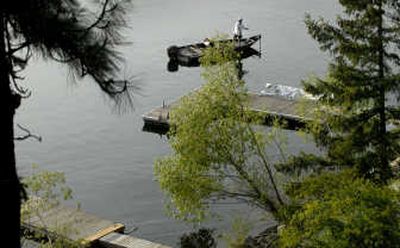Hauser has its own unique claim to fame

If it’s lucky, a small town comes to be known for something unique, and hopefully special, about its area.
Bayview has its recreational opportunities and its miniature submarines. Spirit Lake has its lake spirits and its riding lawn mower drag races. Athol has its name. Rathdrum has its small-town atmosphere for city folks who don’t want to live in the cities they work in. Stateline has – never mind.
Hauser has things to offer, too. In fact, for its size, Hauser has a lot of things to offer – some of which can be found nowhere else. One thing not especially unique in Kootenai County, Hauser has a lake – Hauser Lake, as you might expect.
Hayden and Hayden Lake, take note. Hauser is a divided city with a small part along state Highway 53 and a larger, discontinuous part around the southern half of the lake. Hauser, however, did not choose to confuse the world by making itself into two cities, Hauser and Hauser Lake.
As with other lake communities, Hauser touts its “quality of life” aspects that include fishing, sailing, personal watercraft, motor boating and swimming on its Web site, www.hauserid.org.
Hauser is also one of those nice little places that, despite its proximity to big cities Post Falls and Coeur d’Alene, has not yet been noticed and overrun. With state Highway 53 and the BNSF Railway separating it from the Rathdrum Prairie, Hauser should be able to remain that way indefinitely.
But even in 1903 Post Falls was seen as a threat to Hauser with “retarded progress in a business way” due to their proximity.
Having only 668 people at the time of the 2000 Census, Hauser was only eight people smaller than Athol and about half the population of Spirit Lake, the town. Actually, Hauser Lake is about half the size of Spirit Lake the lake, too.
Hauser is also one of the youngest towns of Kootenai County, celebrating its 60th anniversary this year. That’s a bit deceptive, however. Hauser was incorporated in 1947 because of some issues concerning slot machines in a bar in the basement of the school, but I don’t want to get into all that.
Hauser was first settled in 1880, had a population of 38 in 1900, and was known as the Village of Hauser Lake. Actually, that’s not exactly true either. Prior to 1886, Hauser Lake was known variously as Mud Lake, Mudd Lake and Sucker Lake. None of those names was destined to make Hauser Lake a tourist destination, that’s for sure.
That’s not the reason the name was changed though. Railroad baron Daniel Chase Corbin built his Spokane Falls and Idaho Railroad into the Coeur d’Alene mining district as a branch off the North Pacific Railroad near the settlement that was near Mud(d) and/or Sucker Lake.
Corbin’s friend and fellow railroad baron, Samuel Thomas Hauser – why do railroad barons use three names? – was appointed governor of Montana Territory about this time and the junction was named in his honor. The name change for the lake followed soon after.
In those days, the area was referred to as the Rathdrum Prairie part of the Spokane Valley. You wouldn’t want to call it that now.
These days, Hauser and its lake have two unique claims to fame. Actually, the first is more a claim to notoriety due to an accident of place and history mostly. Obviously, railroads have been important in Hauser’s history.
So, it seemed only logical that when BNSF Railway decided to build a refueling depot in the area in 2004, they applied Hauser’s name, even though the depot is closer to Rathdrum.
But the story is well known how the Hauser Mainline Refueling Facility, at an initial cost of $42 million, has so far placed 145 million gallons of diesel fuel atop the Spokane Valley/Rathdrum Prairie Aquifer that supplies drinking water to half a million people, and almost immediately began to leak.
Another $10 million and 1,800 gallons of leaked fuel later, the Hauser facility is back in business servicing 25 locomotives a day where five main BNSF lines converge. All that mess and controversy has absolutely nothing to do with Hauser itself, but for the use of the long-dead governor’s name.
On a more positive note, Hauser’s true claim to fame is in its lake. In 1994 the Idaho state record green sunfish, at 5 ounces and 7.375 inches, was taken from Hauser Lake. Then, in 1995, and in each of the years 1997 through 2001, a new state record tiger muskellunge was taken from Hauser Lake. The 2001 record stands at 38 pounds, 7 ounces, 48.25 inches long, with a girth of 22.5 inches.
Besides these two species, Hauser Lake supports largemouth bass, crappie, perch, bluegill, trout, kokanee, channel catfish, bullhead catfish and pike.
Oh, one last thing. On July 4, 1947, 200 people at the Hauser Lake festivities saw a UFO. I don’t know how that might relate to present-day Hauser, but you never know.